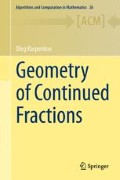Abstract
In this chapter we continue to study integer conjugacy classes of integer matrices in general dimension. Namely we are aiming to contribute to the following problem: describe the set of integer conjugacy classes in \(\operatorname{SL}(n,{\mathbb{Z}})\). Gauss‘s reduction theory gives a complete geometric description of conjugacy classes for the case n=2, as we have already discussed in Chap. 7. In the multidimensional case the situation is more complicated. It is relatively simple to check whether two given matrices are integer conjugate, but to distinguish conjugacy classes is a much harder task. Using multidimensional Gauss’s reduction theory, we give the solution to this problem for matrices whose characteristic polynomials are irreducible over the field of rational numbers. We study questions related to the three-dimensional case in more detail.
Access this chapter
Tax calculation will be finalised at checkout
Purchases are for personal use only
References
H. Appelgate, H. Onishi, The similarity problem for 3×3 integer matrices. Linear Algebra Appl. 42, 159–174 (1982)
K. Briggs, Klein polyhedra. http://keithbriggs.info/klein-polyhedra.html
A.D. Bryuno, V.I. Parusnikov, Klein polyhedra for two Davenport cubic forms. Math. Notes - Ross. Akad. 56(3–4), 994–1007 (1995). Russian version: Mat. Zametki 56(4), 9–27 (1994)
J. Buchmann, A generalization of Voronoĭ’s unit algorithm. I. J. Number Theory 20(2), 177–191 (1985)
J. Buchmann, A generalization of Voronoĭ’s unit algorithm. II. J. Number Theory 20(2), 192–209 (1985)
H. Davenport, On the product of three homogeneous linear forms. I. Proc. Lond. Math. Soc. 13, 139–145 (1938)
H. Davenport, On the product of three homogeneous linear forms. II. Proc. Lond. Math. Soc. (2) 44, 412–431 (1938)
H. Davenport, On the product of three homogeneous linear forms. III. Proc. Lond. Math. Soc. (2) 45, 98–125 (1939)
H. Davenport, Note on the product of three homogeneous linear forms. J. Lond. Math. Soc. 16, 98–101 (1941)
H. Davenport, On the product of three homogeneous linear forms. IV. Proc. Camb. Philos. Soc. 39, 1–21 (1943)
J.W. Demmel, Applied Numerical Linear Algebra (Society for Industrial and Applied Mathematics, Philadelphia, 1997)
F.J. Grunewald, Solution of the conjugacy problem in certain arithmetic groups, in Word Problems II, Oxford, 1976. Stud. Logic Foundations Math., vol. 95 (North-Holland, Amsterdam, 1980), pp. 101–139
K. Hessenberg, Thesis, Technische Hochschule, Darmstadt, Germany, 1942
O. Karpenkov, On the triangulations of tori associated with two-dimensional continued fractions of cubic irrationalities. Funct. Anal. Appl. 38(2), 102–110 (2004). Russian version: Funkc. Anal. Prilozh. 38(2), 28–37 (2004)
O. Karpenkov, On two-dimensional continued fractions of hyperbolic integer matrices with small norm. Russ. Math. Surv. 59(5), 959–960 (2004). Russian version: Usp. Mat. Nauk 59(5), 149–150 (2004)
O. Karpenkov, Three examples of three-dimensional continued fractions in the sense of Klein. C. R. Math. Acad. Sci. Paris 343(1), 5–7 (2006)
O. Karpenkov, Constructing multidimensional periodic continued fractions in the sense of Klein. Math. Comput. 78(267), 1687–1711 (2009)
O. Karpenkov, Multidimensional Gauss reduction theory for conjugacy classes of SL(n,Z). Preprint (2012)
E.I. Korkina, Two-dimensional continued fractions. The simplest examples. Tr. Mat. Inst. Steklova 209, 143–166 (1995)
E.I. Korkina, The simplest 2-dimensional continued fraction. J. Math. Sci. 82(5), 3680–3685 (1996)
G. Lachaud, Polyèdre d’Arnol’d et voile d’un cône simplicial: analogues du théorème de Lagrange. C. R. Acad. Sci., Sér. 1 Math. 317(8), 711–716 (1993)
G. Lachaud, Voiles et Polyhedres de Klein (Act. Sci. Ind., Hermann, 2002)
A. Markoff, Sur les formes quadratiques binaires indéfinies. Math. Ann. 15(3–4), 381–406 (1879)
J.-O. Moussafir, Voiles et Polyédres de Klein: Geometrie, Algorithmes et Statistiques. Docteur en sciences thèse, Université Paris IX—Dauphine, 2000
R. Okazaki, On an effective determination of a Shintani’s decomposition of the cone \(\mathbf{R}^{n}_{+}\). J. Math. Kyoto Univ. 33(4), 1057–1070 (1993)
J.M. Ortega, H.F. Kaiser, The LL T and QR methods for symmetric tridiagonal matrices. Comput. J. 6, 99–101 (1963/1964)
V.I. Parusnikov, Klein’s polyhedra for the seventh extremal cubic form. Technical report, preprint 79, Keldysh Institute of the RAS, Moscow (1999)
V.I. Parusnikov, Klein polyhedra for the fourth extremal cubic form. Math. Notes - Ross. Akad. 67(1–2), 87–102 (2000). Russian version: Mat. Zametki 67(1), 110–128 (2000)
V.I. Parusnikov, Klein polyhedra for three extremal cubic forms. Math. Notes - Ross. Akad. 77(4), 566–583 (2005). Russian version: Mat. Zametki 77(3–4), 523–538 (2000)
T. Shintani, On evaluation of zeta functions of totally real algebraic number fields at non-positive integers. J. Fac. Sci., Univ. Tokyo, Sect. 1A, Math. 23(2), 393–417 (1976)
J. Stoer, R. Bulirsch, Introduction to Numerical Analysis, 3rd edn. Texts in Applied Mathematics, vol. 12 (Springer, New York, 2002). Translated from the German by R. Bartels, W. Gautschi and C. Witzgall
L.N. Trefethen, D. Bau, Numerical Linear Algebra (Society for Industrial and Applied Mathematics, Philadelphia, 1997)
G.F. Voronoĭ, On a Generalization of the Algorithm of Continued Fraction. Collected Works in Three Volumes (USSR Ac. Sci, Kiev, 1952) (in Russian)
Author information
Authors and Affiliations
Rights and permissions
Copyright information
© 2013 Springer-Verlag Berlin Heidelberg
About this chapter
Cite this chapter
Karpenkov, O. (2013). Gauss Reduction in Higher Dimensions. In: Geometry of Continued Fractions. Algorithms and Computation in Mathematics, vol 26. Springer, Berlin, Heidelberg. https://doi.org/10.1007/978-3-642-39368-6_21
Download citation
DOI: https://doi.org/10.1007/978-3-642-39368-6_21
Publisher Name: Springer, Berlin, Heidelberg
Print ISBN: 978-3-642-39367-9
Online ISBN: 978-3-642-39368-6
eBook Packages: Mathematics and StatisticsMathematics and Statistics (R0)

